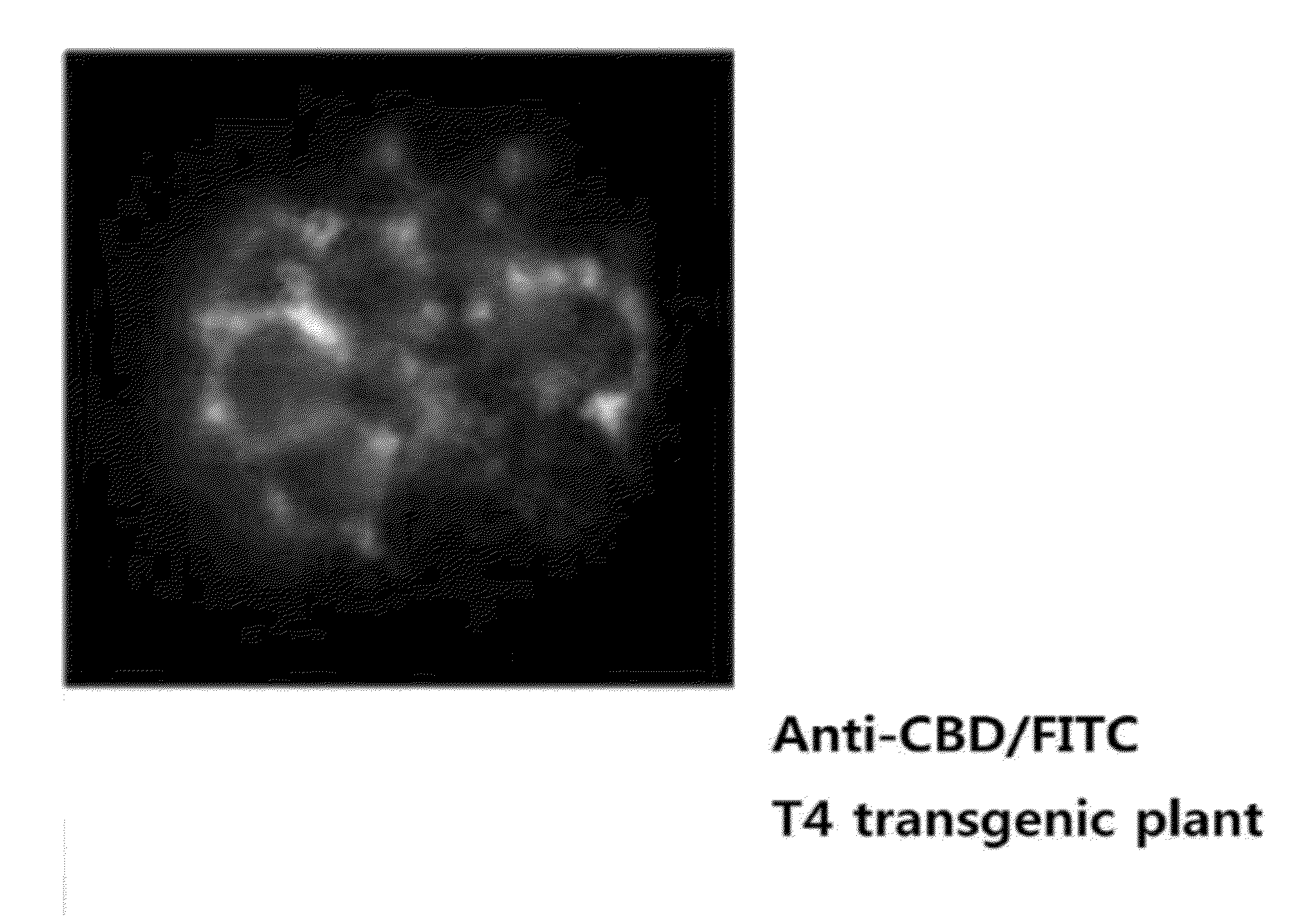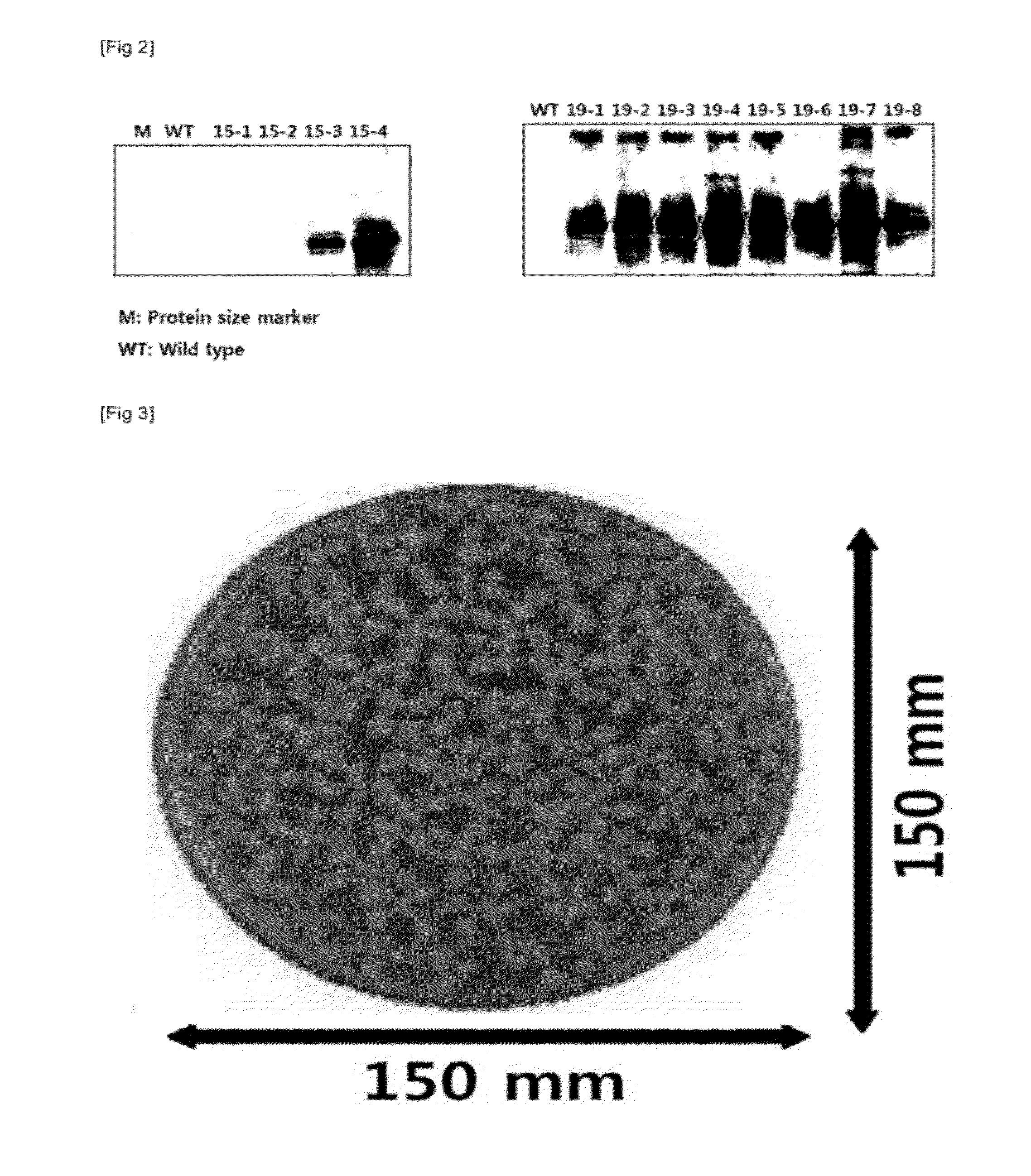Highly pathogenic avian influenza virus protein vaccine derived from transgenic plant, and preparing method thereof
a technology of avian influenza virus and protein vaccine, which is applied in the direction of immunological disorders, drug compositions, peptides, etc., can solve the problems of difficult to prevent infection by other serotypes, no effective vaccine for preventing avian influenza, and enormous economic damage, etc., to achieve quick and easy preparation
- Summary
- Abstract
- Description
- Claims
- Application Information
AI Technical Summary
Benefits of technology
Problems solved by technology
Method used
Image
Examples
example 1
Preparation of the Vector for Plant Transformation Comprising the Antigenic Gene of H5N1 Virus
[0095]In order to produce the vector for plant transformation comprising the antigenic hemagglutinin (HA) gene on the surface of the HPAI (H5N1) virus, the present inventors used the recombinant vector comprising a DNA fragment for improving the translational efficiency, which improves the translational efficiency of a heterologous protein, developed by the present inventors and described in the Korean Patent Application No. 2009-0081403. That is, for the recombinant vector for plant transformation used in the present invention, the present inventors linked the region of a sequence comprising: cauliflower mosaic virus 35S promoter; the DNA fragment which improves the translational efficiency of heterologous protein, which is a 5′ UTR (5′ untranslated region) and a polynucleotide having nucleotide sequence of SEQ ID NO: 6 among polynucleotides having nucleotide sequences of SEQ ID NOs: 1 to ...
example 2
Preparation of the Transgenic Plant which Expresses HA of H5N1 Virus
[0096]Arabidopsis thaliana which expresses HA of H5N1 virus was prepared with the recombinant vector for plant transformation prepared in Example 1 using Agrobacterium sp.-mediated transformation, the method known in the art. The recombinant vector for plant transformation prepared in Example 1 used pBI121 as a base vector. Since pBI121 vector has a kanamycin resistance as selectable marker in plants, Arabidopsis thaliana transformed with the recombinant vector prepared by the method of the present invention was selected using kanamycin resistance test. From Arabidopsis thaliana selected with the kanamycin resistance test, the first generation transformant was established by selecting lines which express HA proteins well through Western blot analysis. Then in the second generation, lines whose ratio of dead individuals:survived individuals measured using a selectable marker was clearly 1:3 were selected as single co...
example 3
Examination of the Location of Hemagglutinin (HA) Antigenic Protein of H5N1 within the Endoplasmic Reticulum in the Transgenic Plant
[0097]As described above, the present inventors used BiP, the signal sequence which transports the HPAI (H5N1) type A / Hong Kong / 213 / 03 hemagglutinin (HA) protein to the endoplasmic reticulum (ER). Therefore, to examine whether the HA protein, which is expressed in the transgenic plant prepared in Example 2, is located in the endoplasmic reticulum, immunostaining was carried out as follows. That is, protoplasts were isolated from the leaves of Arabidopsis thaliana, which was transformed with pBI121-35Sp-UTR35:BiP:H5N1(HA):CBD:HDEL:NOS, and then lysed in W6 buffer (154 mM NaCl, 125 mM CaCl2, 2.5 mM Maltose, 5 mM KCl, 10 mM HEPES, pH7.2). 300 μL of the transformed protoplasts lysed in the W6 buffer were placed on a slide coated with poly-L-lysine and 3% paraformaldehyde was treated thereto for about 1 hr. The transformed protoplasts was fixed and then wash...
PUM
| Property | Measurement | Unit |
|---|---|---|
| pH | aaaaa | aaaaa |
| pH | aaaaa | aaaaa |
| pH | aaaaa | aaaaa |
Abstract
Description
Claims
Application Information
 Login to View More
Login to View More - R&D
- Intellectual Property
- Life Sciences
- Materials
- Tech Scout
- Unparalleled Data Quality
- Higher Quality Content
- 60% Fewer Hallucinations
Browse by: Latest US Patents, China's latest patents, Technical Efficacy Thesaurus, Application Domain, Technology Topic, Popular Technical Reports.
© 2025 PatSnap. All rights reserved.Legal|Privacy policy|Modern Slavery Act Transparency Statement|Sitemap|About US| Contact US: help@patsnap.com



